Is your preschooler struggling with grasping crayons, buttoning shirts, or using scissors? Do you worry that their small hand movements aren’t keeping up with the rest of their development? Are you unsure what kinds of fine motor activities are truly effective, and how to integrate them into your daily routine at home or in the classroom?
The best fine motor activities for preschoolers are play-based, developmentally appropriate tasks that strengthen hand and finger coordination, support early handwriting, and build independence. They are essential because they lay the neurological and muscular foundation for skills like drawing, dressing, using utensils, and manipulating objects—key components of school readiness and everyday functioning.
These foundational abilities don’t just happen on their own. Children need frequent, intentional practice—through engaging activities that don’t feel like drills. In this article, I’ll walk you through 50 proven fine motor activities tailored for preschoolers, explain how they connect to educational frameworks like Montessori and EYFS, and share practical tips for parents and educators to support every child’s fine motor journey.
What Are Fine Motor Skills?
Fine motor skills refer to the ability to control and coordinate the small muscles of the hands and fingers. These skills are used every day—from turning a page in a book to tying shoelaces. Unlike gross motor skills, which involve large muscle groups and whole-body movement, fine motor skills focus on precision, grip, and dexterity.
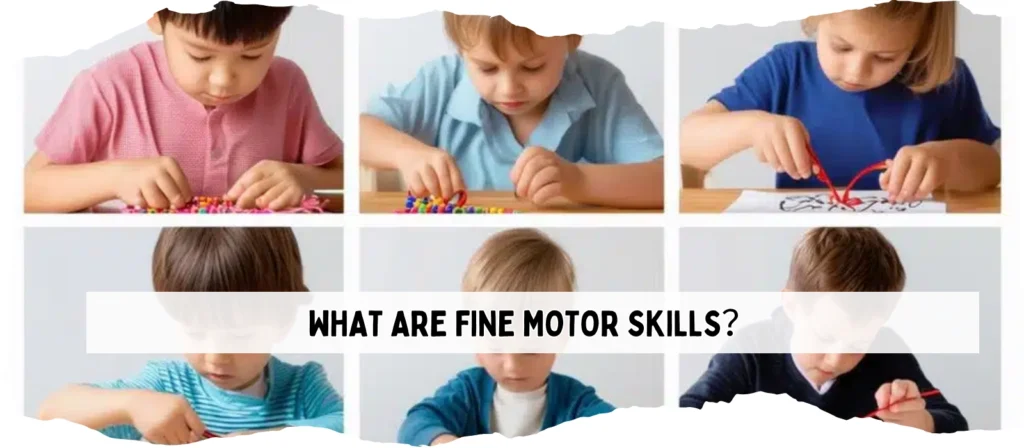
These skills begin to emerge in infancy and develop rapidly through early childhood. Children learn to isolate their fingers, stabilize their wrists, and control their palm movements—each one necessary for manipulating small tools and objects. Over time, these basic abilities support higher-level academic tasks such as writing, drawing, and even typing on a keyboard.
Fine motor development is closely tied to neurological growth. Each time a child picks up a crayon or uses tweezers to grasp a pom-pom, neural pathways are firing and strengthening. These repeated movements enhance brain connections that support executive function, memory, and motor planning—skills that extend far beyond physical development.
In preschool classrooms, fine motor practice is integrated into daily routines through playful, hands-on exploration. Activities like cutting, building, threading, and squeezing not only engage the child but also refine these essential micro-movements needed for lifelong independence.
Why Fine Motor Activities Are So Important to Preschoolers
Preschoolers are at a developmental stage where their brains are highly receptive to learning new skills. Fine motor activities are not just optional play—they are essential exercises that build control, coordination, and confidence. During the ages of 3 to 6, the brain develops complex neural pathways that support hand-eye coordination, muscle precision, and bilateral integration.
These activities go beyond improving grip strength—they are deeply connected to a child’s ability to learn. Children with well-developed fine motor skills can draw shapes, form letters, and hold utensils with greater ease. This allows them to actively participate in classroom routines, boosting both academic performance and social integration.
In addition, children who engage in regular fine motor practice often display better emotional regulation. These tasks require patience and focus, helping kids develop persistence and self-control. Educators often use fine motor activities at the start of the school day as a calming transition that prepares students to learn.
Without structured fine motor opportunities, children may struggle with key developmental milestones such as using scissors, tying shoes, or zipping jackets. This can result in frustration, reduced self-confidence, and dependence on adults for simple tasks. Providing daily opportunities to strengthen these skills supports autonomy and sets the stage for long-term success.
Fine Motor Activities for Toddlers (6–12 Month Olds)
At 6 to 12 months, babies are just beginning to explore the world with their hands. While they are still developing basic gross motor control, this stage is ideal for introducing early fine motor activities that focus on sensory exploration, object manipulation, and grasp development.
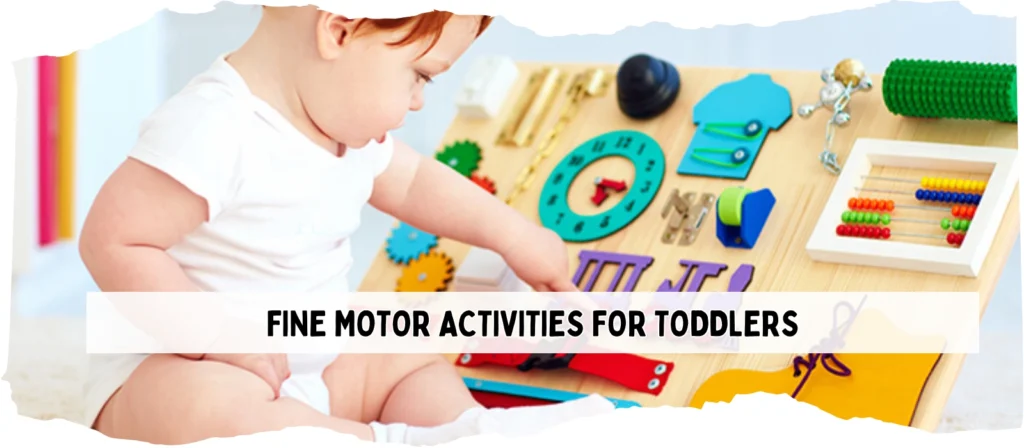
Sensory Play for Tactile Stimulation
Simple activities like exploring textured materials such as fabric books, silicone teethers, or crinkly paper help babies build hand awareness and sensitivity. This encourages babies to reach, squeeze, and manipulate, enhancing both touch processing and intentional movement.
Grasping and Releasing Toys
Offer soft, lightweight rattles and stacking cups to encourage grasp and release motions. This promotes the development of finger isolation and hand strength, both of which are critical for object control and early tool use.
Reaching and Poking
Babies can practice poking, pushing, and pointing with their index fingers using large buttons, pop-up toys, or sensory mats. These motions build early finger precision and begin the bilateral movement patterns that lead to tasks like holding paper and cutting.
Floor Play and Tummy Time
During tummy time, place reachable toys slightly out of arm’s length to encourage stretching and grabbing. Toys that squeak or make noise when squeezed can motivate effort and extend attention span.
Repetition and Daily Routine
Short, repeated sessions of supervised play throughout the day help reinforce muscle memory. Everyday caregiving routines like diaper changes and feeding become ideal moments to offer safe hand-held items for baby to explore.
Fine Motor Activities for 1–2 Year Olds
Between 12 and 24 months, toddlers become increasingly curious and mobile, opening up new opportunities for targeted fine motor development. At this age, children are refining their grasp, exploring with both hands, and starting to show preference for a dominant hand—all important milestones in fine motor progress.
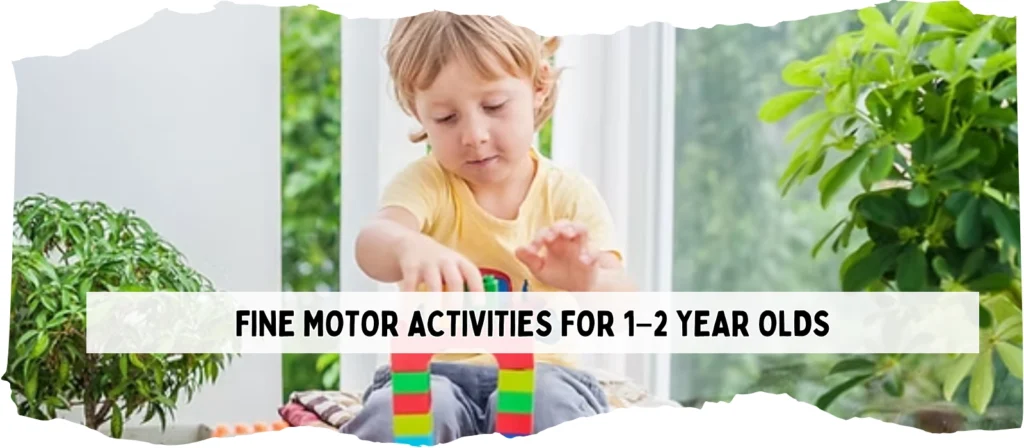
Building with Blocks
Introduce small but safe building blocks like soft foam or large interlocking pieces. Stacking, knocking over, and rebuilding towers encourages hand control and eye-hand coordination. You can add variety by using blocks of different textures and sizes to challenge grip adaptation.
Scribbling with Crayons
Thick crayons or triangle grip crayons are perfect for little hands. Let toddlers explore vertical and horizontal strokes freely on large sheets of paper. Early scribbling lays the groundwork for controlled strokes needed in pre-writing skills and creative expression.
Finger Foods and Self-Feeding
Offering small pieces of fruit, cheese cubes, or cereal encourages pincer grasp and coordination during snack time. Use divided plates and small bowls to give toddlers more control, and gradually introduce toddler forks and spoons to expand utensil practice.
Nesting Cups and Shape Sorters
These classic toys support visual-motor integration and hand control. Toddlers learn about size, shape, and spatial reasoning while practicing grasp-and-release patterns. Encourage trial and error as a learning process, not just completion.
Stickers and Velcro Boards
Peeling and sticking foam stickers or manipulating Velcro pieces helps strengthen fine finger control and supports bilateral hand use, which is critical for dressing and self-care skills. These tools also build focus and planning, key parts of executive function.
Fine Motor Activities for 2–3 Year Olds
As toddlers transition into early preschoolers, their fine motor abilities become more deliberate, coordinated, and skill-driven. The 2 to 3-year-old stage is perfect for refining foundational movements and introducing more purpose-driven, educational play.
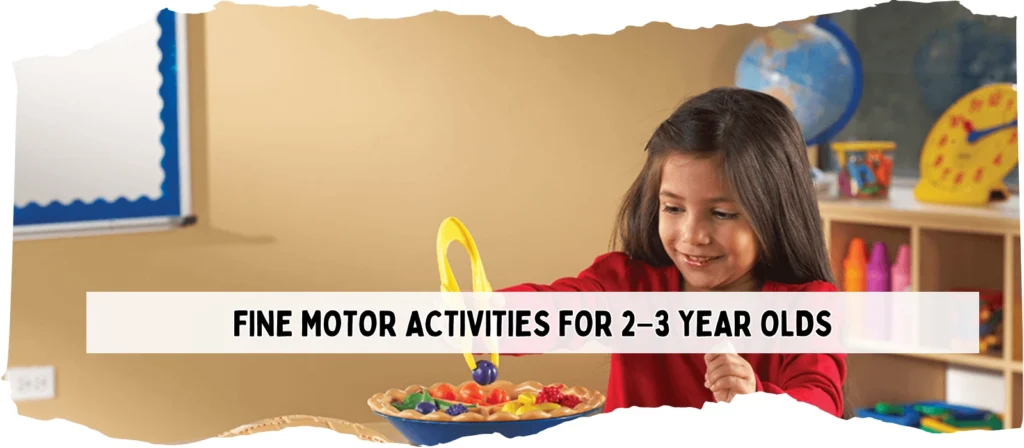
Playdough Pinching and Rolling
Manipulating soft dough strengthens finger muscles and builds wrist flexibility. Have children roll snakes, flatten shapes, or pinch small balls of dough for tactile and strength training. Add tools like plastic knives, rollers, or cookie cutters to increase variety and build tool use.
Simple Puzzles and Peg Boards
Age-appropriate wooden puzzles or chunky peg boards help improve spatial perception, hand-eye coordination, and problem-solving—all while exercising grasp and release movements. Encourage verbal interaction as children solve the puzzle to link language and motor planning.
Lacing Cards and Beads
Lacing large beads onto strings or threading yarn through punch-out cards helps develop bilateral coordination and early concentration skills. This activity also strengthens the arches of the hand, important for more advanced writing and tool use.
Easy Squeeze Tools
Use toddler-safe tweezers, tongs, or eyedroppers to transfer small objects like cotton balls or pom-poms between containers. Introduce games like color matching or sorting to incorporate cognitive challenges along with physical coordination.
Marker and Chalk Drawing
Introduce washable markers or sidewalk chalk for coloring within borders. These tools provide smoother resistance than crayons and challenge toddlers to control pressure and direction. Try large stencils or tracing templates to further refine motor control.
Fine Motor Activities for 3–4 Year Olds
Preschoolers aged 3 to 4 are typically ready for more structured and skill-based fine motor activities. At this stage, their hand strength, control, and endurance have improved significantly, making it the perfect time to introduce more complex fine motor activities for preschoolers that enhance dexterity, coordination, and precision. These activities also directly support academic skills like drawing, writing, and manipulating small tools.
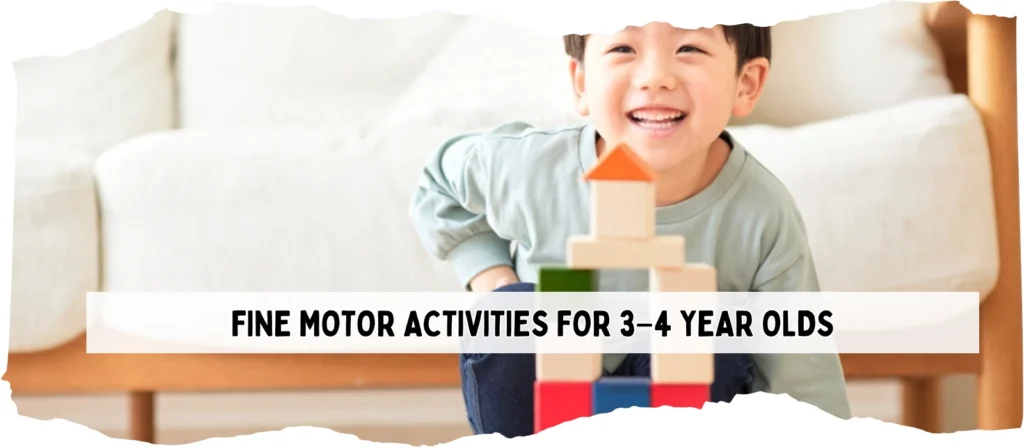
Cutting with Scissors
Provide child-safe scissors and thick paper to allow preschoolers to practice straight-line and curved cutting. Cutting is one of the most effective fine motor activities for preschoolers because it combines hand strength, bilateral coordination, and visual-motor integration. Begin with cutting playdough or snipping straws for easier resistance before moving on to more complex shapes.
Tracing Shapes and Letters
Tracing is excellent for preparing preschoolers for writing. Use templates or dotted-line worksheets that allow children to trace basic shapes, numbers, and eventually letters. These fine motor activities build pencil control and muscle memory for future handwriting.
Sticker Art and Collages
Encourage children to peel and place stickers within outlines or create their own sticker art scenes. This activity develops fingertip control and reinforces spatial awareness. Combine stickers with paper cutouts and glue sticks to allow for multi-step fine motor work.
Threading and Weaving
Give children plastic needles and lacing boards or shoelaces and large-hole beads. Weaving ribbons through holes or stringing beads in patterns helps improve bilateral hand use, sequencing skills, and attention span.
Play-Based Tool Use
Introduce child-sized tools like mini hammers with foam boards, screwdrivers with practice bolts, or pretend kitchen tools. These role-play fine motor activities are fun and mimic real-world movements, enhancing hand-eye coordination and strengthening the whole hand.
Each of these fine motor activities for preschoolers is designed to provide both physical strengthening and cognitive development. With the right environment and materials, 3–4 year olds can thrive through engaging, purposeful practice that prepares them for kindergarten and beyond.
Fine Motor Activities for 4–5 Year Olds
At 4 to 5 years old, preschoolers begin to show more refined control of their fingers and hands, enabling them to tackle activities that require precision, speed, and sequencing. Fine motor activities for this age group should focus on pre-writing and school readiness, while also continuing to support independence in everyday tasks. Children at this stage enjoy creative challenges and hands-on tasks that let them see immediate results.
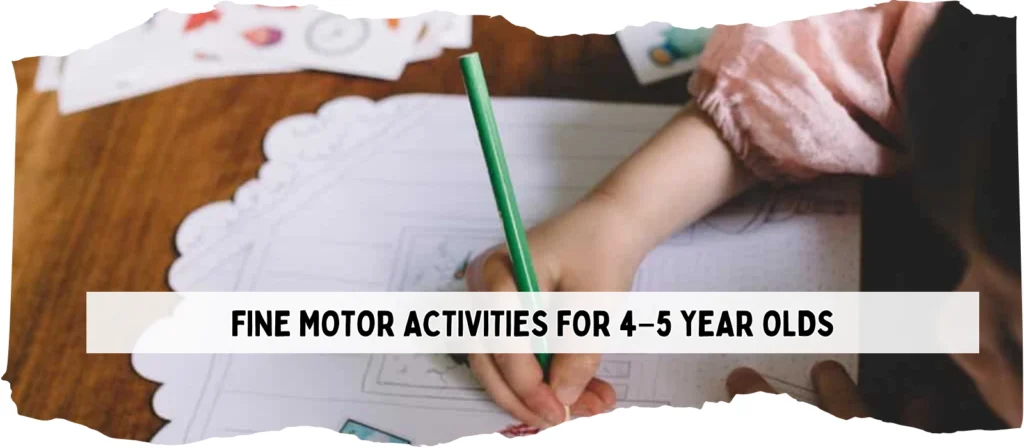
Pencil Control and Pre-Writing Practice
Preschoolers can start using thinner writing tools, such as regular crayons or triangular pencils. Provide worksheets with lines, mazes, and alphabet tracing to improve visual tracking and finger control. These fine motor activities for preschoolers help build endurance and posture needed for writing.
Cutting Complex Shapes
Move beyond straight lines to cutting out curves, zigzags, and shapes. Offer construction paper with designs to follow or crafts that involve assembling parts. Cutting with intention refines both motor control and problem-solving.
Buttoning, Snapping, and Zipping
Set up a dressing station with old clothes or activity boards that include zippers, buttons, buckles, and snaps. These functional fine motor skills promote independence in dressing and support muscle strength in the fingers and palms.
Small Object Manipulation
Introduce tweezers, tongs, and chopsticks for sorting activities using small items like buttons, beads, or pom-poms. Sorting by color, size, or pattern adds a cognitive element to fine motor coordination.
Building and Construction Play
Use interlocking blocks, nuts and bolts, or magnetic tiles. These activities engage both fine motor precision and spatial reasoning. Ask children to build models or patterns based on pictures to challenge attention to detail.
These fine motor activities for preschoolers aged 4–5 form the bridge between playful exploration and kindergarten readiness. They help children gain mastery over their hands while encouraging creativity, independence, and confidence in school-related tasks.
Fine Motor Activities for 5–6 Year Olds
Children aged 5 to 6 are typically in their final year of preschool or beginning kindergarten. At this stage, they need fine motor activities that build strength, precision, and stamina—especially in preparation for writing, drawing, and independent self-care. These fine motor activities for preschoolers blend academics with hands-on tasks to support multiple areas of development.

Writing and Drawing Practice
Encourage frequent use of pencils, crayons, and markers for writing letters, drawing scenes, and even labeling objects. Introduce lined paper to reinforce directional writing and sentence structure. Offer stencils and tracing books to add variety and focus.
Crafting with Detail
Offer projects that involve cutting, pasting, folding, and designing—such as paper dolls, origami, or collage-making. These art-based fine motor activities improve focus and visual-motor skills. Encourage multi-step directions for building sequencing and memory.
Self-Care Practice Stations
Support fine motor independence by setting up daily living tasks like brushing hair, opening lunch containers, buttoning jackets, and tying shoelaces. Use routine charts with pictures to guide their progression.
Typing and Technology Use
Introduce basic typing games or interactive tablets with drag-and-drop features and simple matching puzzles. These activities combine finger precision with digital literacy in an age-appropriate format.
Advanced Building and STEM Play
Provide tools like LEGO bricks, marble runs, pegboards, or STEM kits that encourage structured creativity. Ask children to follow visual instructions or build symmetrical shapes. These experiences sharpen both motor control and logic.
By age 6, most children should feel confident with their hands—gripping tools properly, writing full names, and completing dressing tasks independently. These fine motor activities not only equip them with school-ready skills but also reinforce their independence and self-confidence.
50 Fun and Easy Fine Motor Activities by Type
This section organizes 50+ fine motor activities into categories to help parents, teachers, and therapists choose the best fit for a child’s needs and interests. Each type supports different aspects of development and engages children through diverse, purposeful play.
Hands-On & Manipulative Activities
Hands-on activities are perfect for building strength and coordination through grasping, pinching, squeezing, and twisting. These tasks directly develop the small muscles in the fingers and hands, crucial for pencil control and self-care tasks.
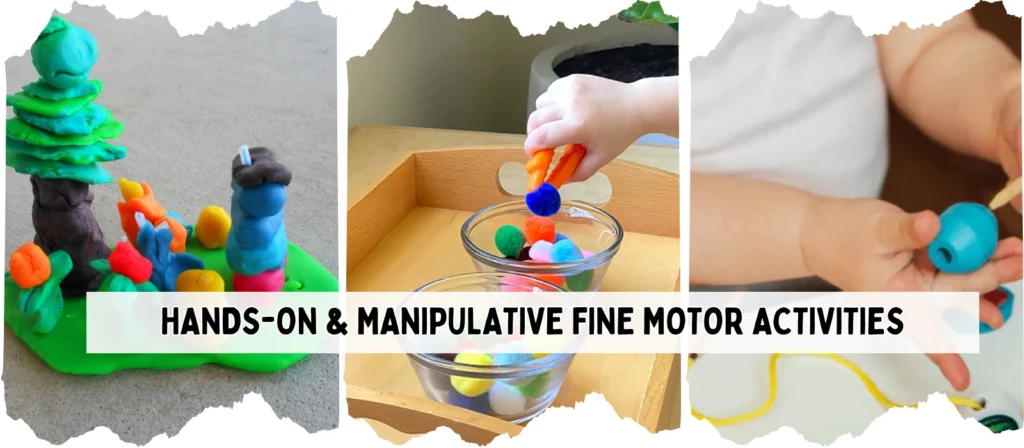
- Playdough Sculpting
Materials: Playdough (store-bought or homemade), cookie cutters, rolling pin, plastic knife
Steps: Let children roll, squish, and mold playdough into shapes, using cutters or hands. Encourage them to make animals, letters, or shapes. - Pom-Pom Transfer with Tongs
Materials: Pom-poms, plastic tongs, ice cube tray or small cups
Steps: Using tongs, children transfer pom-poms from one container to another. Add color-matching or counting challenges to extend learning. - Beading
Materials: Pipe cleaners or string, large and small beads
Steps: Children thread beads onto pipe cleaners or laces. Begin with large beads and progress to smaller ones to build precision. - Sorting Games
Materials: Buttons, coins, small toys, sorting trays or muffin tins
Steps: Children sort objects by size, color, or shape into divided trays. Incorporate tweezers for extra finger control. - Puzzle Assembly
Materials: Age-appropriate puzzles with knobs or interlocking pieces
Steps: Provide puzzles that require twisting and turning pieces. Increase complexity gradually to maintain engagement.
Cutting, Tracing, and Writing Tasks
Cutting and tracing are essential pre-writing skills that help with hand-eye coordination and grip refinement. These are great fine motor activities for preschoolers preparing for writing tasks.
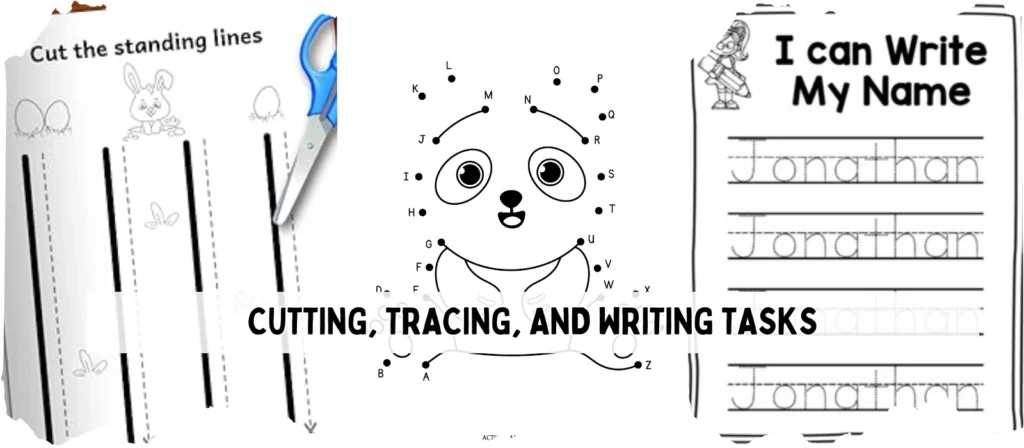
- Cutting Lines and Shapes
Materials: Safety scissors, printable cutting sheets, playdough snakes
Steps: Start with cutting straight lines, then shapes. For added fun, let kids cut playdough into segments. - Tracing Paths and Letters
Materials: Pencils, crayons, tracing paper or printable worksheets
Steps: Let children trace over dashed lines and shapes, eventually progressing to letters and numbers. - Dot-to-Dot Activities
Materials: Dot-to-dot printables, pencil or marker
Steps: Children connect dots in numerical order to form a picture. This encourages focus and hand control. - Name Writing Practice
Materials: Lined paper, dry erase boards, name templates
Steps: Have kids trace or write their names daily. Use finger tracing on laminated sheets for early learners. - Shape and Letter Punching
Materials: Hole punch, printed outlines of shapes or letters
Steps: Kids punch holes along the edges of letters or shapes, following dotted lines.
Art-Based and Creative Fine Motor Play
Art fosters creativity while refining finger movement and coordination. These fine motor activities are ideal for enhancing visual-motor integration.
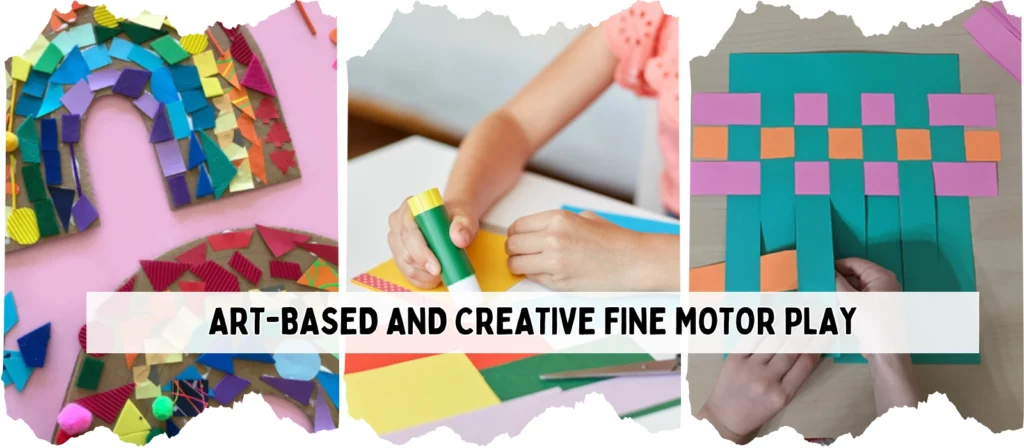
- Sticker Collages
Materials: Various stickers, construction paper
Steps: Kids peel and place stickers into patterns or on drawn outlines, encouraging precision and design. - Glue Stick Projects
Materials: Paper shapes, glue sticks, themed printables
Steps: Provide themed templates for children to decorate using paper shapes and glue. - Paper Weaving
Materials: Two colors of construction paper, scissors, ruler
Steps: Cut slits into one paper and weave strips from another color through it to form a woven mat. - Finger Painting
Materials: Washable finger paint, paper, smocks
Steps: Let children finger-paint freeform or trace patterns. Great for tactile exploration and control. - Stamp Art
Materials: Stamps, washable ink pads, paper
Steps: Kids press stamps onto paper to create patterns or scenes. Encourage grip changes and two-hand use.
Sensory and Coordination Focused Activities
These activities stimulate the senses while refining coordination and body awareness. Ideal for children needing more sensory input or balance of motor skills.
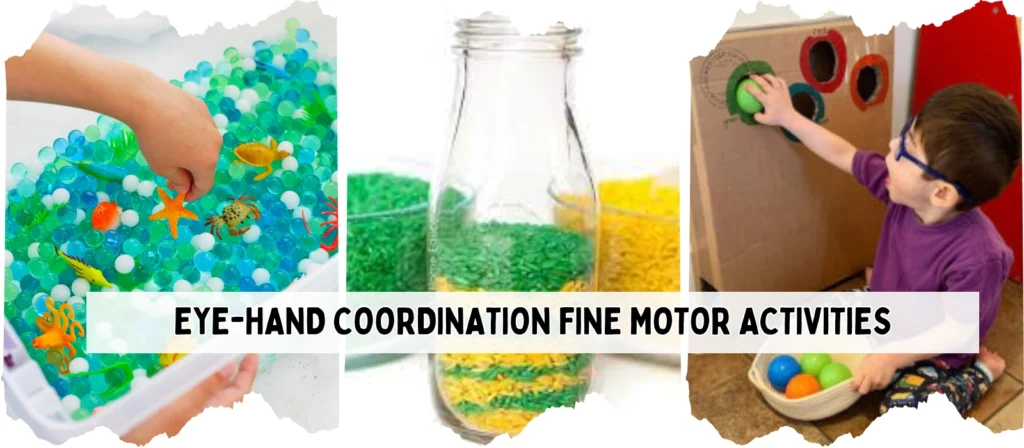
- Sensory Bins
Materials: Bin filled with rice, beans, or sand; hidden small toys
Steps: Let children dig through the bin to find small items, using fingers or tongs. - Scooping and Pouring
Materials: Cups, scoops, dry materials (rice, water beads)
Steps: Kids practice scooping and pouring between containers to build control and focus. - Eye-Hand Coordination Fine Motor Activities
Materials: Beads and laces, balls and buckets, stacking toys
Steps: Encourage games that require aiming, catching, threading, or stacking. - Balance and Reach
Materials: Tape, paper, stickers on wall surfaces
Steps: Stick paper shapes on walls and ask children to reach and touch or place stickers precisely. - Pin the Pom-Pom
Materials: Tweezers, glue, pom-poms, themed paper sheets
Steps: Kids pick up pom-poms with tweezers and glue them onto designated spots.
Fine Motor Activities for Holidays & Seasons
Seasonal and holiday-themed fine motor activities add festive fun to developmental play. Great for classroom events or home routines.
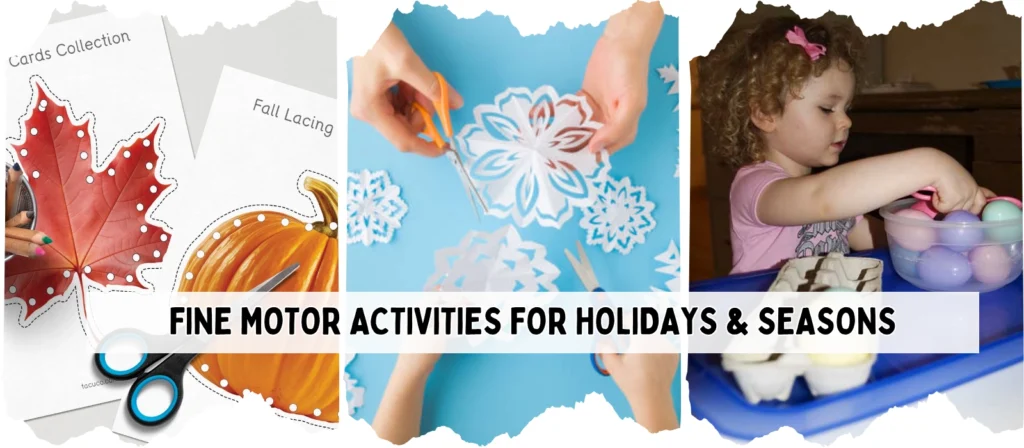
- Pumpkin Lacing Cards (Fall)
Materials: Pumpkin-shaped cards with holes, yarn, plastic needles
Steps: Children lace yarn through the holes, following the outline of the pumpkin. - Snowflake Cutting (Winter)
Materials: Paper, safety scissors
Steps: Fold paper and cut simple designs to create snowflakes. - Heart Sticker Patterns (Valentine’s Day)
Materials: Heart stickers, paper, markers
Steps: Kids place stickers in lines, shapes, or patterns, optionally tracing or coloring around them. - Egg Transfer (Easter)
Materials: Plastic eggs, tongs, basket
Steps: Children use tongs to transfer eggs from one place to another. - Firework Stamping (4th of July)
Materials: Kitchen sponge pieces, red/white/blue paint, paper
Steps: Dip sponge strips into paint and press onto paper in starburst shapes.
These fine motor activities are diverse, engaging, and developmentally appropriate. With materials and step-by-step instructions, caregivers can confidently implement targeted strategies that promote strong fine motor skills in any learning environment.
How Parents Can Actively Support Fine Motor Growth at Home
Fine motor activities aren’t limited to school or therapy settings—parents can make a huge impact right at home. By embedding purposeful movements into daily routines and encouraging repeated practice, children naturally strengthen their hand and finger skills.
Everyday Chores Turned into Fine Motor Practice
Many household tasks double as excellent fine motor activities for toddlers and preschoolers. Involving children in these tasks not only builds responsibility but also provides real-life practice in coordination and control.
- Folding Washcloths or Sorting Laundry: Encourage your child to fold small towels or match socks by color and size.
- Helping in the Kitchen: Let them peel bananas, stir batter, or spread butter with a plastic knife.
- Feeding Pets: Scooping kibble into bowls builds hand stability and eye-hand coordination.
Use of Simple Tools for Repetitive Practice
You don’t need fancy equipment. Many everyday items support fine motor development when used regularly and creatively:
- Clothespins: Use them to hang paper art or count by pinning numbered cards to a string.
- Tweezers and Tongs: Great for sorting beans or transferring small toys.
- Sponges and Spray Bottles: Kids love wiping surfaces or watering plants—excellent for grip strengthening.
- Pipe Cleaners and Beads: Easy threading activities improve pincer grasp and visual tracking.
Creating a Fine Motor Station at Home
Dedicate a small area of your home for fine motor practice. Include:
- Containers of pom-poms, buttons, and beads
- A tray for cutting and gluing
- Playdough and safe tools
- Pre-drawn tracing sheets or activity books
Encourage your child to spend 10–15 minutes a day exploring these activities. Consistent, low-pressure exposure helps children gain confidence and skill over time.
Use Routine Moments for Quick Wins
Incorporate fine motor tasks into transitions and downtime:
- Buttoning pajamas at bedtime
- Opening lunch containers at snack time
- Drawing or sticker play during waiting periods
The more children use their hands purposefully, the better their fine motor development becomes.
Home-based fine motor activities are simple, affordable, and effective. With patience and encouragement, parents can help children build lifelong skills in the most natural setting of all—their everyday environment.
Step-by-Step Strategies to Enhance Fine Motor Skills
Enhancing fine motor skills doesn’t have to feel like a chore—for the child or the adult. By breaking down tasks, using supportive tools, and turning exercises into playful experiences, we can guide children toward meaningful and measurable skill improvements.
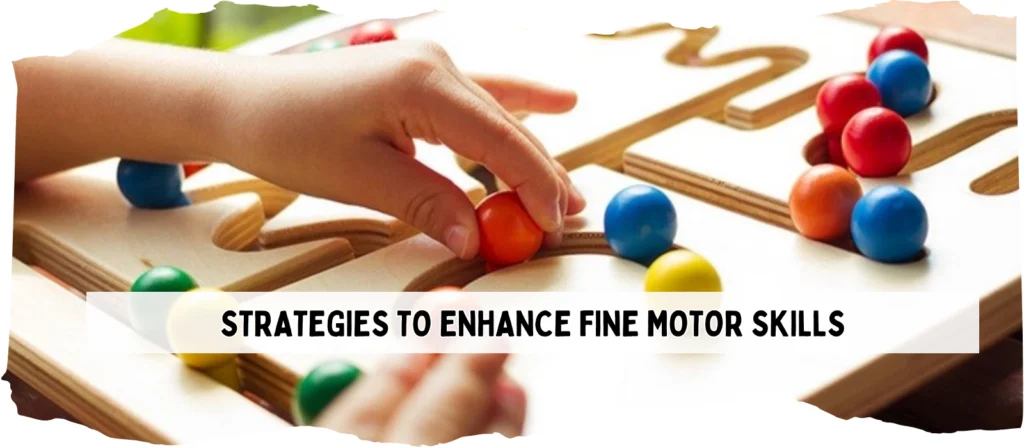
Embed Movement Practice into Play Scenarios
Integrate fine motor activities naturally into play to ensure engagement and enjoyment. Turn any favorite game or toy into an opportunity to strengthen the hands and fingers:
- Use action figures to pinch, grasp, and move small parts
- Set up a “mini market” and have children use toy coins and tongs
- Create sensory play scenes with beads, dough, or stickers that promote focused manipulation
Play-based learning is especially helpful for fine motor activities for preschoolers who respond best to imagination-driven tasks.
Simplify Tasks with Clear Micro Steps
Children with emerging motor skills benefit from tasks that are clearly broken down:
- Demonstrate one small action at a time
- Use visual cards or a step-by-step photo chart
- Repeat steps often so they become familiar
For example, instead of saying “Cut out the shape,” break it down into “Hold paper with your left hand,” “Open scissors,” “Start at the line,” etc. This strategy improves success and reduces frustration.
Leverage Supportive Tools and Modifications
Adaptive equipment can make challenging tasks accessible. Consider using:
- Pencil grips for improved writing control
- Loop scissors for reduced hand strain
- Rubber grips on utensils for better grasp during mealtimes
- Tabletop slant boards to promote wrist alignment while drawing or tracing
Occupational therapy fine motor activities often recommend these tools, especially for children with additional motor delays or low muscle tone.
Make Engagement Enjoyable and Rewarding
Positive feedback and motivation are key. Here’s how to keep children interested:
- Use sticker charts or visual progress boards
- Celebrate small wins like successfully buttoning a shirt or cutting a circle
- Let them choose activities or themes (e.g., superheroes, animals, holidays)
The more children feel successful, the more they will want to practice—building confidence along with coordination.
Build Habits Through Gentle Repetition
Repetition strengthens motor memory. Encourage:
- Daily short bursts of practice (5–10 minutes)
- Incorporating the same types of activities into routines (e.g., threading beads after lunch)
- Using the same objects across different contexts to reinforce skills
With consistency and patience, fine motor activities for toddlers and preschoolers turn from isolated exercises into natural, daily habits.
These strategies are grounded in best practices and recommended by early educators and occupational therapists alike. Implementing them can result in long-term success in fine motor development across all age groups.
OT Fine Motor Activities
Occupational therapists (OTs) are specialists in helping children develop essential life skills—including fine motor skills. Many of their recommendations combine professional insight with playful, practical applications that parents and educators can easily adopt. Whether you’re supporting a child with developmental delays or simply enhancing preschool readiness, these OT-approved fine motor activities are highly effective.
Common OT Tools and Games
OTs often introduce tools and activities specifically designed to improve hand strength, coordination, and control. These can include:
- Theraputty Exercises: Children stretch, squeeze, and roll resistive putty to build finger and palm strength.
- Scissor Skills Stations: Pre-cut patterns or zigzag lines on paper help with control and visual tracking.
- Tweezer Games: Using tweezers to sort beads or pom-poms by color enhances pincer grasp and focus.
- Lacing Cards and Bead Strings: Develop sequencing and bilateral coordination.
- Peg Boards and Pincer Activities: Support dexterity and eye-hand coordination.
All these are staples in occupational therapy fine motor activities. They combine muscle work with brain engagement.
Therapy-Backed Skill Extensions
OTs often scale up or down activities based on a child’s current abilities:
- For beginners: Larger materials like jumbo beads and loop scissors are used to accommodate developing hands.
- For intermediates: Add structured multi-step tasks like paper weaving or using tongs in pattern play.
- For advanced practice: Encourage children to copy sequences, fold origami, or complete puzzles with fine pieces.
These progressive steps are key to developing sustainable fine motor skills in both educational and therapeutic contexts.
OT Tips for Parents and Educators
To support occupational therapy strategies at home or school, try:
- Daily 10-minute practice using the same tools to build consistency
- Using a visual schedule or task board to set clear expectations
- Praising effort, not just results to boost motivation
Children benefit from low-pressure, high-consistency environments where their improvements are noticed and celebrated.
By incorporating OT fine motor activities into the home or classroom, we can offer children the structured support they need—while still making it fun and rewarding. These exercises build not just small muscles, but also big confidence.
Activities for Children with Autism or Developmental Delays
Children on the autism spectrum or with developmental delays often benefit from targeted fine motor activities that support sensory regulation, focus, and independence. These activities are designed to accommodate varying abilities while reinforcing consistent skill-building.
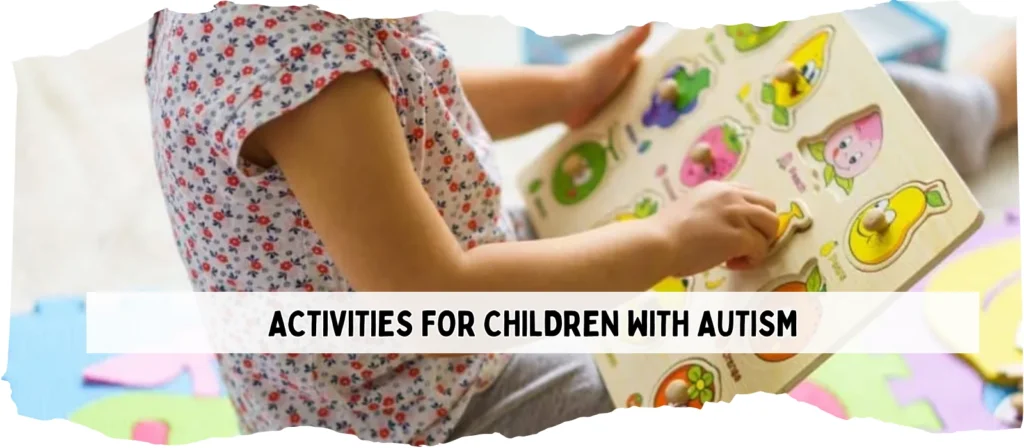
Personalized Strategies for Unique Needs
Autistic children may process motor tasks differently. Adjusting activities to align with their interests and sensitivities can increase engagement:
- Use favorite characters or themes (e.g., dinosaurs, trains) in tracing, lacing, or cutting activities.
- Allow for sensory preferences: Soft textures, low-noise tools, and weighted objects can increase comfort.
- Introduce clear routines: Visual instructions and task boards help children follow multi-step activities independently.
Focused Activities That Promote Independence
Fine motor skills for autism often involve repetition, structure, and simple cause-effect learning. Try:
- Velcro Boards: Attaching and detaching tabs strengthens grip and provides tactile feedback.
- Sorting Games with Tongs: Boosts hand strength while practicing categorization and control.
- Sticker Activities: Picking, peeling, and placing stickers help with dexterity and coordination.
- Threading and Buttoning Practice: Mimics real-world dressing tasks and supports functional independence.
Enhancing Focus and Reducing Overwhelm
To avoid overstimulation:
- Limit background distractions
- Offer activities in a quiet corner
- Present one task at a time
Many autism fine motor skills activities benefit from shorter, repeated sessions throughout the day rather than one long stretch.
With patience and the right strategies, fine motor activities for autism become not only skill-building exercises, but also moments of connection, joy, and progress.
Montessori-Inspired Fine Motor Strategies
The Montessori method offers a rich foundation for building fine motor skills in a natural, self-directed way. Rather than rigid instruction, it encourages purposeful play and independence through tactile learning and real-world tasks. These principles are a perfect match for promoting fine motor development.
Practical Life Activities
Montessori fine motor activities often center on daily life skills. These help children gain control, confidence, and coordination.
- Pouring grains or water between containers: Enhances wrist control and hand stability.
- Spoon transferring exercises: Builds precision and control, especially when using small beads or lentils.
- Buttoning frames and zipper boards: Prepares children for self-dressing while developing finger dexterity.
- Using clothespins or tweezers: Strengthens pincer grip and hand muscles.
Sensorial Learning Through Touch
Montessori tools like sandpaper letters, geometric solids, and texture boards develop both sensory awareness and fine motor precision. These tools are excellent for children aged 3–6 who are preparing for writing.
- Tracing sandpaper letters with two fingers: Builds muscle memory for future handwriting.
- Exploring different textures: Encourages fine discrimination and control.
- Sorting and matching activities: Engage attention and hand-eye coordination.
Environment That Supports Independence
Montessori classrooms and homes are carefully arranged to give children access to hands-on materials they can manage independently. This builds intrinsic motivation to repeat fine motor activities until mastery is achieved.
- Use child-sized trays, natural materials, and clearly defined workspaces.
- Rotate materials periodically to sustain interest and challenge.
By integrating Montessori fine motor strategies, we empower children to take charge of their development, while offering them tools that are engaging, calming, and educational.
EYFS Fine Motor Skills Activities
Aligning fine motor activities with the Early Years Foundation Stage (EYFS) and Pre-K curriculum ensures that skill-building is both developmentally appropriate and pedagogically relevant. It supports the broader goals of early childhood education: preparing children for formal schooling through hands-on learning.

Key Developmental Goals
Both EYFS and Pre-K place strong emphasis on physical development, including coordination, control, and movement. Fine motor activities are directly linked to these areas, especially in preparation for writing and self-care tasks.
- EYFS: Early learning goals specify children should handle tools effectively and show increasing control and confidence.
- Pre-K: Frameworks emphasize readiness for tasks like using scissors, drawing basic shapes, and beginning to write letters.
Activity Mapping
Many of the activities described in this article fit seamlessly into early learning objectives:
- Threading and lacing games align with dexterity development
- Cutting and gluing projects enhance bilateral coordination
- Art and pre-writing tracing build pencil control and shape recognition
Educators can use these activities as informal assessments to track progress toward motor milestones.
Integration Tips for Educators
- Plan themed stations based on curriculum topics (e.g., seasons, holidays, animals)
- Use simple rubrics to evaluate progress on fine motor benchmarks
- Collaborate with OT or special education staff to support differentiated needs
Incorporating these activities into lesson plans creates an engaging, multisensory path toward academic and motor readiness—benefiting children across developmental levels.

Frequently Asked Questions (FAQ)
Q: What are fine motor activities for preschoolers?
Fine motor activities for preschoolers include actions like cutting with scissors, stringing beads, using tweezers to pick up objects, and drawing shapes. These activities help build hand strength, coordination, and dexterity—key for writing and self-care.
Q: How can I improve my child’s fine motor skills at home?
Use simple tools like clothespins, playdough, buttons, and tongs in short, playful sessions. Integrating fine motor skills activities into daily routines—like helping zip a jacket or stir pancake batter—makes practice meaningful.
Q: What materials do I need for fine motor skill activities?
Common tools include pom-poms, tweezers, scissors, beads, buttons, pegs, clothespins, and lacing cards. You can also repurpose items like cereal boxes, paper straws, and kitchen tongs.
Q: Are fine motor activities helpful for children with autism?
Yes. Autism fine motor skills activities help develop precision, focus, and independence. Sensory-friendly options like Velcro boards or sticker tasks offer effective practice without overstimulation.
Q: How do fine motor skills support kindergarten readiness?
Children with strong fine motor skills can write letters, color within lines, open containers, and dress independently. These abilities directly impact their confidence and success in a kindergarten setting.
Q: How often should fine motor activities be practiced?
Consistency is key. Practicing 10–15 minutes a day, several times a week, is ideal for most preschoolers. Short, focused sessions work better than long or forced ones.
Q: What’s the difference between fine and gross motor skills?
Fine motor skills involve small muscle movements in fingers and hands, while gross motor skills use larger muscle groups for activities like jumping or running. Both are essential for child development.
Q: Can fine motor activities help with handwriting?
Absolutely. Activities like tracing, threading, and clay modeling strengthen the muscles needed for pencil grip and letter formation, making handwriting easier and more accurate.
Q: Where can I find printable worksheets for fine motor practice?
Websites like Teachers Pay Teachers, Twinkl, and Pinterest offer a wide range of free and paid fine motor activity worksheets for different age levels.
Q: Are there seasonal or holiday-themed fine motor activities?
Yes—Christmas, Halloween, Thanksgiving, and other holidays offer perfect themes for cutting crafts, sticker patterns, and sensory bins that support fine motor development in a fun, relevant way.
Conclusion
Fine motor skills activities aren’t just play—they are foundational building blocks for school success, self-care, and lifelong independence. At XIHA Furniture, we understand how essential these early learning opportunities are. That’s why we design our preschool furniture and tools to support every child’s developmental journey.
Whether you’re an educator planning a hands-on classroom, or a parent supporting your child at home, now is the time to integrate purposeful fine motor activities into your daily routine.



